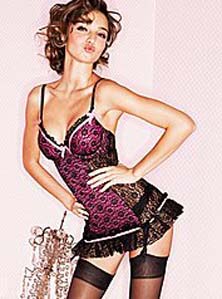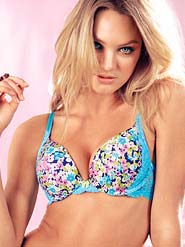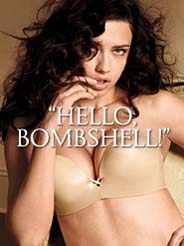







When observing any of the images from advertisements featured on the Victoria's Secret website or in magazines, the overt sexuality is most likely one of the first things that a viewer would notice. It is practically as if the model is selling herself rather than the lingerie that she is wearing. By positioning herself in sexual positions and showing off her female assets, a Victoria's Secret model is simply perpetuating stereotypes associated with the ideas of women in American society and contributing to the male gaze. This male gaze allows viewers to objectify the women in the lingerie, while other viewers might identify with her more than objectify her. However, by allowing room for the male gaze to be present, Victoria's Secret advertisements interpellate men and show them what kind of women they should desire and fantasize about.
In line with this male gaze, women are encouraged to want what men want. By viewing the Victoria's Secret model in a way that is tailored toward the view of a man, women begin to identify themselves with the model and strive to achieve her standard of beauty. By claiming that Victoria's Secret advertisements set the bar for female attractiveness, it must be said that women, in turn, want to attain this standard in order to please men. In this way, Victoria's Secret not only interpellates men in a fetishistic scopophilia manner, but also women in an identifiable fashion, which then persuades the female audience to purchase Victoria's Secret's products. In essence, the voyeurism and fetishistic scopophilia of the male audience is put in contrast to the mirror phase and narcissistic identification for the female audience. In addition to the advertisements in magazines and online, Victoria's Secret has a famous line of commercials by a Director Michael Bay, who specializes in special effects and other "manly" visuals. In order to see an example of one of his commercials, click the link below: Michael Bay Commercial
In order to fully analyze how these commercials interpellate men into the world of Victoria's Secret, we must focus on some of the still shots. For example, this photo of three Victoria's Secret models in lingerie posing in front of three planes, a stereotypical manly object. It is not an everyday occurrence to see three thin models in lingerie and high heels walking in front of planes at the airport, but Bay included this image in the commercial in order to catch male attention. The camera is angled upward, giving the male viewer the ability to observe the entirety of the models' bodies while still being able to view the planes in the background; it is a fantasy-come-true for many men. The models are also in dark lingerie to mirror the colors of the planes, but the color of their skin gains salience as a result, allowing men to focus on the idea of female nudity while still taking in the whole visual.
Another still shot from the commercial is this image with a model in lingerie placed on a motorcycle. By the way she is positioned, it is apparent that she is not riding the motorcycle, but rather enticing the male viewer by being an object of male desire while sitting on top of another object of male desire. This particular model is making direct eye contact with the viewer, making the male audience believe that she is only looking at them and asking them to "come hither." This direct eye contact has the ability to also interpellate women, but in a different way. With a female viewer's knowledge that the model is interpellating her male viewers, the female may have the opportunity to become jealous, encouraging her to strive to become like the model in order to attract men. The model's physical positioning is also key in this image because she is blatantly emphasizing her chest, pouting her lips, and letting her hair flow freely in the wind, all ideal stereotypes of the perfect woman.
A third image from Bay's commercial is this image of three Victoria's Secret lingerie models in front of an explosion. In reality, if there were an explosion, three women would not normally stop and pose in front of it, but rather run from it. However, these women have no fear in their eyes—only determination. They are all looking directly at the camera as if to bring the male viewer directly to them, but they are also in strong feminine stances as if to intimidate the male viewer and lend them an air of being unattainable. All of their lingerie is black, adding a sensual aspect to an otherwise harsh picture, and all of their backs are arched, displaying their feminine features for men to fantasize about.
The last still shot as a site of analysis in Bay's commercial is this image of a Victoria's Secret lingerie model on top of a pool table. Following the pattern, she is arching her back and therefore displaying her feminine assets, but she is also holding a pool stick, which can be interpreted as a phallic symbol or as the model taking control, both of which have the ability to be appealing to a male audience. Pool is another activity that is commonly associated with men, so the fact that she is mounted on top of a pool table allows men to fantasize about themselves as the pool table. Although the model is not making eye contact with the camera, her broken gaze interpellates the men by leaving them wanting more.
All of these images interpellate both men and women in completely different ways. By setting an idea for the "perfect" woman, Victoria's Secret is able to gain a male audience by taking advantage of fetishistic scopophilia while simultaneously interpellating women and emphasizing to them that in order to keep men interested, a woman must look like the models in their advertisements and promoting narcissistic identification. If one fails to do so, then the ideal woman that is the model will always be the standard to which she can not measure up, causing a shift in identification and self-esteem.
 |
 |
 |
 |
 |
| Homepage | Psychoanalysis | Discourse Analysis | Audience Studies | I Love My Body |
Lewis, Reina. "Looking Good: The Lesbian Gaze and Fashion Imagery." The Visual Culture Reader. Ed. Nicholas Mirzoeff. 2nd ed. London: Routledge, 2002. 654-68. Print.
Reichart, Tom. "Does Sex in Advertising Work?": A Review of Scholarly Research Informed by Professional Opinion. Advertising and Society Review (2007). Project Muse. Web. 25 Apr. 2011.
Scott, Linda M. "Market Feminism: The Case for a Paradigm Shift." Marketing and Feminism: Current Issues and Research. Ed. Miriam Catteral, Pauline MacLaran, and Lorna Stevens, 16-38. London: Routledge, 2000.
Figure 1: http://www.dailymail.co.uk/tvshowbiz/article-1233487/Victorias-Secret-star-Miranda-Kerr-sizzles-Christmas-ad-offering-thousand-fantasies.html
Figure 2: http://www.glamourvanity.com/celebrities/hot-michael-bay-for-victorias-secret/
Figure 3: http://fooyoh.com/iamchiq_living_lifestyle/4356619
Figure 4: http://www.marisamiller.com/blog/2009/11/vs-holiday-campaign/
http://www.victoriassecret.com/
May 2, 2011